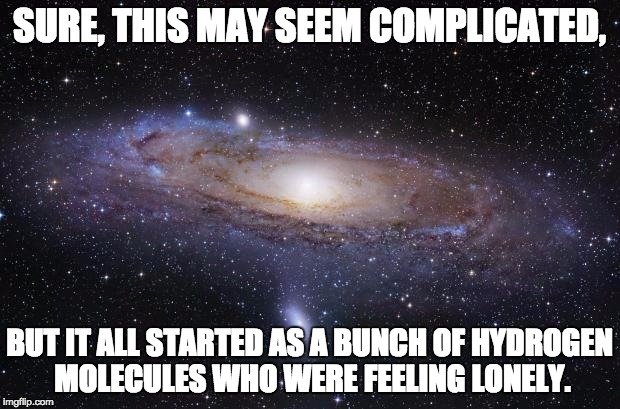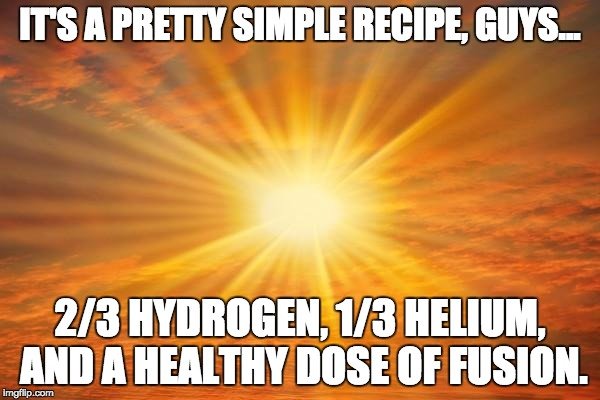Table of Contents (click to expand)
The hydrogen in stars comes from the Big Bang.
When we look up at the stars in the night sky, you are seeing the visible radiation from stars that billions or trillions of miles away. Similarly, when you bask in the glow of the Sun on your face on Earth, you are being warmed by that same radiation, energy that has been pushed out of our solar system’s star. What most people don’t know is that energy is the result of nuclear fusion happening in the core of the sun. That nuclear fusion leads to massive amounts of hydrogen being used as energy.
If the sun has been burning for the better part of 5 billion years, how has it not run out of hydrogen yet? And more importantly, where did the sun get all that hydrogen in the first place?
Short answer – the Big Bang, but there’s a lot more to it than that…

The Beginning Of The Universe
After the Big Bang, which occurred roughly 13.8 billion years ago, the universe was expanding at an incredible rate, and the maelstrom of energy and subatomic particles was like nothing we can conceive. Everything in the known universe is present as a result of the Big Bang, but in the beginning, things were a lot simple.
The initial outrush of energy led to the formation of subatomic particles, namely protons, neutrons and electrons, but they were all so fired up with energy and speed and temperature that they were flying past one another uncontrollably. Eventually, however, as the cosmic soup began to cool (and continued to expand, mind you), those protons and electrons began to find one another and bond. One proton and one electron is the chemical makeup of hydrogen. Believe it or not, hydrogen is the most abundant element in the universe, representing about 3/4 of the known mass of the universe. This is followed by helium, and more distantly, by oxygen.
Now, when these hydrogen and helium atoms coalesced in the very beginning of the universe, they formed massive clouds of particles, sometimes hundreds of thousands of light-years across. For a long time, there is a balance between the inward force of gravity and the outward pressure of the molecules on one another, but at some point, this threshold is crossed. This caused these huge clouds of particles to begin collapsing in on themselves, forming small areas of extremely dense particles that would eventually become stars.

We see examples of this today in older galaxies, commonly known as blue dwarf galaxies, which do not have the variety of other heavier elements that younger galaxies had during their star-making process, yet they are still prolific stellar cradles.
Also Read: Where Did The Elements Come From?
A Star Is Born
Now, when those collapsing particles form a ball, heat and density begin to increase considerably, as does the gravitational strength, which brings in more material from the surrounding space. When the pressure outside of this “ball” matches the pull from gravity, a protostar has officially been born. Based on the access to raw material, namely hydrogen and helium, a star can move in a few different directions.
If the star is low on raw materials, it will never build up enough density or mass to “ignite”, so to speak, and will become what we commonly know as brown dwarfs. However, if a star does have enough density and heat at its core to ignite, something very exciting happens. Deuterium fusion is the next step, where a hydrogen atom, which has one proton and one electron, takes on a neutron. This is the most basic form of fusion, and can stop the collapse of the star in on itself; the engine has begun. However, stars are said to reach their “main phase” of life once hydrogen fusion begins.
Essentially, the immense pressure and density, charged with the heat of those pressurized atoms, will cause a chain reaction in the protons of the hydrogen, which will convert the element into helium.
Nuclear fusion of this kind gives off incredible amounts of energy, and when thousands upon thousands of protons are all colliding and fusing every second, it can make for quite an exploding ball of gas… also known as a star.
Throughout the life of a star, the ratio of hydrogen to helium changes (initially, it is about 70% hydrogen and 30% helium). As more and more hydrogen is converted into helium through nuclear fusion, the core becomes more and more dense with helium, and the outer hydrogen core continues to burn, but not as brightly, and the burning region is happening further and further away from the core. However, don’t be too worried about the hydrogen running out; remember that it makes up 75% of the universe… there’s plenty of it still left out there!
Also Read: What Is The Life Cycle Of A Star ?
The Lifespan Of A Star
It can be difficult to conceive the massive size of a star, just as it is difficult to imagine the size of a hydrogen molecule, or the vastness of space, but suffice to say that when a star forms, it typically gears up for 3-5 billion years of fusion. Granted, some of the more unusual stars, like supergiants, may consume their hydrogen at incredible rates and burn up in just a few million years, ending in a dramatic supernova. On the other extreme, some stars are wildly efficient, like red dwarfs, and will likely have enough fuel to last for hundreds of billions of years, but even then… all things die.
When a star dies, a number of things can happen, but when it comes to the formation of the universe, nothing has ever been more helpful than supernovae. When a star “goes nova”, it explodes in one of the most spectacular sights in the universe, spewing its heavier core elements across the universe, to help seed other star clusters. This is how our star was formed, more than 8 billion years after it all started – from the leftover bits of debris from supernovae and the original hydrogen particles that formed after the Big Bang.
How well do you understand the article above!

